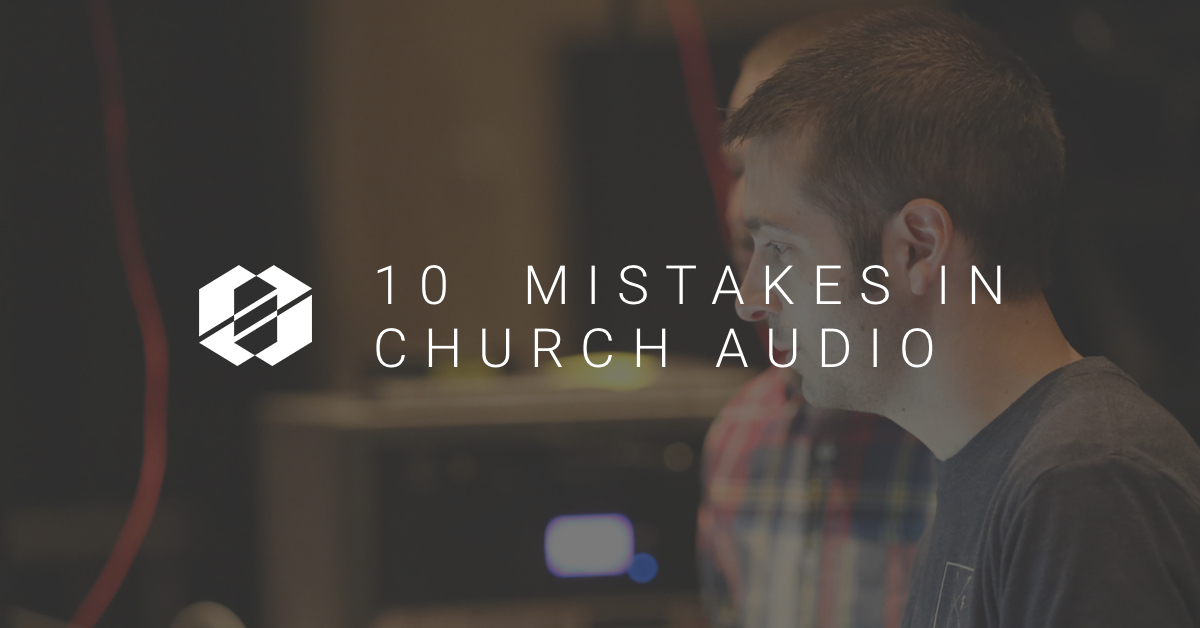To a tech guy, “mistake” is a dirty word. Every week your congregation relies on you to bring the Word to them via hearing it. The worse thing that you could do is not be prepared for potential problems or even trained on the most basic tasks and in turn not allow the congregation to fully hear the Word. In my experience, here are the 10 biggest mistakes in church audio.
Being Unprepared for Soundcheck.
Several weeks ago I wrote an article for SALT on the 7 steps to running a successful soundcheck. This may sound like a no-brainer, but being unprepared for soundcheck is something I have seen and experienced (and been guilty of) more often than I can count.
As I have said before there is value in systems, processes, checklists, and procedures. Creatives can be hesitant to put things in writing…in black and white. But, it’s in the black and white that you save time and add moments for your creativity or creative abilities to shine through. There are two main steps to being prepared for your role on Sunday.
First is communication. A great sound check begins before Sunday ever gets here. Communicate early and often in order to get the information you need to be ready. (i.e. band, vocalists, tracks, etc.) Whether that is through planning center, a google doc, text messages or something else, find a way to get the details ahead of time.
The second step is going to be all about your prep Sunday morning before the band walks in. Do as much prep as you can before the band hits the stage. Place and test mics, set monitors, ring the room, dial in your overall EQ… Essentially, do whatever you need to do to be sure that you are ready for the band to arrive.
Over Trusting the Tools.
Never before have so many tools been more affordable and readily available for church audio metering and analyzing than today. From spectrum analyzers to SPL Meters, from digital consoles to iOS apps, there are almost an infinite number of tools available to measure, meter, analyze, and “listen” to the mixes we create. However, don’t forget to listen with your own ears. If something doesn’t sound right to you, but the spectrum analyzer says it’s ok…it’s probably not. Take that opportunity to dig in, isolate the oddity and fix it. Your ears are the best tool you have to ensure a great mix for worship.
Mixing to the Meters
Whether you are looking at your SPL meter for level or your spectrum analyzer for your overall EQ, don’t forget to simply listen. Tools are great at helping craft great sound quality, but they can be a crutch from simply listening to the mix. Just because a meter is showing one thing, it doesn’t mean it’s accurate (especially across the entire room.) Be sure you listen to what’s going on.
Not Walking or Knowing The Room.
Far too often have I seen church audio techs mix from the sound booth and never walk the room. Which is rough, because in so many churches the console is not in a great spot in the room. Maybe it’s tucked under a balcony, up on the balcony, on the side of the room or even worse.
Mixing Too Loud
The biggest rule of thumb to remember in church audio is this: mix to create a worship environment. This isn’t about you, the PA, how great the worship team is, or anything else. It’s about creating an atmosphere that allows the congregation to enter in.
But, what is too loud? There are a few factors to consider such as
- size of your room,
- quality of your gear (from mics to console to PA,)
- tone of your service,
- age of your congregation,
- the aesthetics of your space.
Generally speaking, you can lock in to a dB range for your room fairly easily. Once you, your pastor, and worship team have found a solid range to keep your mix located in, from there you’ll want to adjust for your audience. More people in the room, the more sound that will be absorbed. The more sound that is absorbed, the louder you may need to mix. Don’t put a piece of tape, hash marks on faders or knobs, or any other type of “controls” in place. Trust your audio engineer to mix at a level that is appropriate for your room.
In addition, this is also where knowing your room will come in handy. If you have people (you usually know who they are) that consistently complain about the volume, even though you have taken the measures above to ensure the mix is where it needs to be, then knowing your room will help you be able to steer them towards other areas of the room that aren’t quite as loud. Many PA’s will have what is termed the “power alley” where the volume goes up simply as the PA hits its focal point. Those who are more sensitive should avoid siting there.
Mix to create a worship environment….It’s about creating an atmosphere that allows the congregation to enter in.
Mixing Too Quiet
Just as mixing too loud can be a big mistake for church audio techs, mixing too quiet can be just as big a problem. It can be awkward, especially for first time visitor’s and guests. If they can easily hear themselves and others off stage singing above the PA. Find the sweet spot where worship and environment meet that you can create an amazing atmosphere for folks to enter in.
No Dynamics
Music isn’t meant to be the same volume during an entire playlist. It should ebb and flow. There should be swells and soft moments. Just as the worship leader works to take the congregation on a journey, us as audio techs should walk that same path. There are moments when it’s time to crank it up to bring energy and vibrancy to the room. And there are other times when the music needs to fade to the background so the voices of the congregation can be heard. Work with your worship leader and band together to see how those moments can have the biggest impact by creating dynamic moments within the setlist.
Gain Structure
Probably the most technical aspect on this list is gain structure. Do you ever feel like you can’t get enough volume out of a channel? Do you have to boost your fader to +5 or +10 to get anything going? It probably means you need to adjust your gain structure. This is where tools, such as your meters, will come in handy. Rely on your tools to see where your gain structure needs to be for each vocalist and instrument. Don’t forget to bypass your comps and gates when setting gain structure. Gain structure is the base for each channel and should be set without competing factors like compression, effects, etc. Once your gain is set, you’ll have the freedom to add those effects to get the sound you desire.
Too Much Low End =
I play bass. So, in my head that’s what I want to hear. However, bass, especially in a worship service can be a big distraction. The level of bass probably shouldn’t pulsate the sacraments off the stage during communion. However, a tiny sound is just as bad. Some rooms, congregations, styles will need and want more bass. This is great. However, overdoing it in any atmosphere can drown out other elements, make it hard for people to focus, and event cause headaches and hearing issues. Be sensitive that bass levels are probably more of an issue for the older population simply due to how our hearing changes over the course of our lifetime.
Being Distracted
Finally, but certainly not the least important is being distracted. Whether it’s Facebook, texts, chatting with others on com, or something else, avoid distractions at all cost. You are called to serve. Whether it’s a 45 minute service, or a three day conference, enter in and be present. Not only will this help you avoid the embarrassing moment of every head turning to look at you when the pastor’s mic isn’t turned on, but you’ll be able to see how the room is reacting to the service and add dynamics and intentionality to how you mix.


